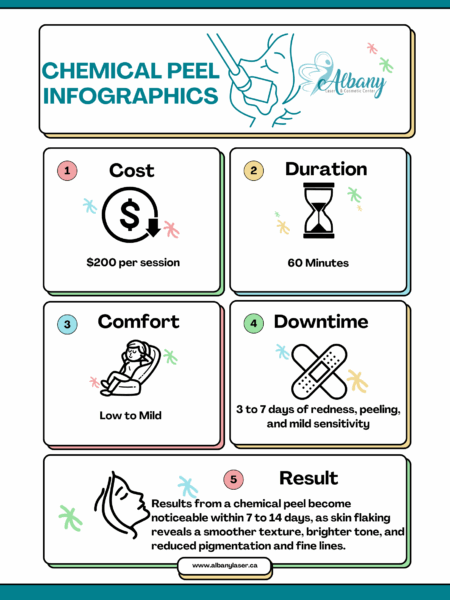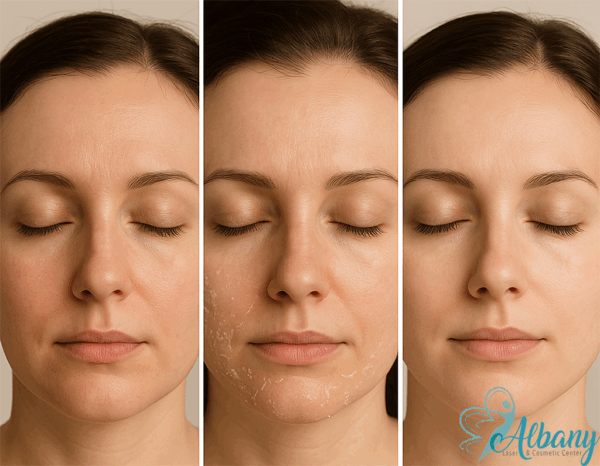Guide to Advanced Chemcial Peels Edmonton
Welcome to Albany Cosmetic and Laser Centre’s comprehensive guide to chemical peels, your ultimate destination for achieving a revitalized and youthful complexion. Our expert team is dedicated to helping you discover the transformative benefits of personalized chemical peel treatments tailored to your unique skin needs.
At Albany Cosmetic and Laser Centre, we understand that every individual’s skin is different. That’s why we offer a range of chemical peel options, each designed to address specific concerns such as acne scars, uneven texture, fine lines, and sun damage. Our advanced chemical peels work by applying a specially formulated solution to exfoliate the top layers of your skin, revealing the fresh, healthy skin underneath. This process not only improves the appearance of your skin but also stimulates collagen production, leading to long-lasting results.
Chemical Peel Summary

Treatment Cost
Procedure Time
Result Duration
Level of Discomfort
Understanding chemical peels
Chemical peels are advanced skincare treatments that involve the application of a chemical solution to the skin, causing it to exfoliate and eventually peel off. This process reveals a new, regenerated layer of skin that is typically smoother, clearer, and less wrinkled than the old skin. Chemical peels can address a variety of skin concerns, including fine lines, wrinkles, acne scars, uneven skin tone, and sun damage. Depending on the depth of the peel—superficial, medium, or deep—different levels of the skin are targeted to achieve the desired results. The American Academy of Dermatology provides a comprehensive, credible summary of chemical peels—covering benefits, risks, and professional guidelines—without competing directly with your content.
How Chemical Peels Work On The Skin
Chemical peels work by applying a specialized chemical solution to the skin, which causes controlled exfoliation and peeling. This process removes the damaged outer layers of the skin, promoting the regeneration of new, healthier skin cells. Depending on the type and strength of the peel—superficial, medium, or deep—the treatment can target different depths of the skin. Superficial peels remove the outermost layer, while medium and deep peels penetrate further to address more significant skin concerns. The result is smoother, clearer, and more youthful-looking skin.
Chemical Peel Results: Before and After Pictures

Witness the transformative effects of chemical peels through our before and after gallery. These genuine patient results demonstrate the powerful impact of our treatments, effectively addressing skin concerns such as uneven texture and signs of aging.
Our gallery highlights significant improvements, offering a clear testament to the rejuvenating benefits of chemical peels. By exploring these images, you can envision the potential outcomes for your skin, making it easier to see how Chemical exfoliation can help you achieve a revitalized appearance. Dive in and experience the transformations for yourself!
Facial peel preparation, treatment day care, and aftercare
3 to 7 Days Before (Preparation)
- Discontinue use of retinoids, exfoliants, and products containing AHA/BHA to prevent excessive irritation.
- Avoid direct sun exposure and apply a broad-spectrum sunscreen with SPF 50 or higher daily.
- Maintain skin hydration with a non-comedogenic moisturizer.
- Refrain from waxing or using depilatory creams on the treatment area.
Treatment Day (What to Expect)
- Arrive at the clinic with a clean, makeup-free face.
- Undergo a pre-procedure assessment to ensure skin readiness.
- The Exfoliation treatment will be applied, during which you might feel mild tingling or warmth.
- Post-treatment, a soothing balm and sunscreen will be applied to protect your skin.
1 to 7 Days After (Immediate Aftercare)
- Expect peeling or flaking to begin 2-3 days post-treatment; avoid picking or peeling off skin to prevent scarring.
- Use a gentle cleanser and apply a rich moisturizer several times daily to combat dryness.
- Minimize sun exposure and apply SPF 50 sunscreen every two hours if outdoors.
- Avoid activities that induce excessive sweating, such as intense exercise.
7 to 14 Days (Ongoing Aftercare)
- Most peeling should subside, revealing fresh, new skin.
- Continue with a gentle skincare routine and avoid using makeup until the skin feels fully healed.
- Gradually reintroduce active ingredients like retinoids under the guidance of your practitioner.
3 to 6 Months (Long-Term Maintenance)
- Maintain healthy skin habits, including daily use of antioxidant serums and sunscreen.
- Consider maintenance peels every 4-6 weeks or as recommended to prolong results.
Frequently Asked Questions
What is a chemical peel?
A chemical peel is a skin rejuvenation procedure that involves applying a chemical solution to remove damaged outer layers, revealing smoother, healthier, and younger-looking skin beneath.
How do chemical peels work?
Facial peels exfoliate the skin by removing dead and damaged cells, stimulating collagen production and encouraging new, healthy skin growth.
Are Chemical exfoliation Treatments painful?
Most people experience mild tingling or a warming sensation during treatment. Deeper peels may cause temporary discomfort, but pain is generally minimal and manageable.
What conditions can chemical peels treat?
Exfoliation treatments effectively treat acne, acne scars, uneven skin tone, hyperpigmentation, sun damage, fine lines, wrinkles, and rough texture.
How often should I get a chemical peel?
What are the side effects of a chemical peel?
Who should NOT get a chemical Peel ?
What are the different types of chemical peels?
Chemical peels are categorized by their depth of exfoliation:
- Light peels (superficial): These target the epidermis to improve skin tone and texture. Examples include glycolic acid peels and salicylic acid peels.
- Medium peels: Penetrating deeper into the dermis, they address pigmentation, wrinkles, and acne scars. A common example is the trichloroacetic acid (TCA) peel.
- Deep peels: These deeply exfoliate to treat significant skin damage, deep wrinkles, and extensive sun damage. Phenol peels are an example of deep chemical peels.
Can I combine chemical peels with other treatments?
Yes, chemical peels are often combined with other skincare treatments, such as microneedling, facials, or laser treatments, for enhanced results.
Are chemical peels suitable for all skin types?
Most skin types can benefit from chemical peels; however, deeper peels may pose risks for darker skin tones due to potential hyperpigmentation. Consult your specialist for personalized recommendations.
Can chemical peels remove deep scars and wrinkles?
Medium to deep chemical peels can significantly reduce the appearance of deeper wrinkles and scars. However, for very deep scars or severe wrinkles, additional treatments like lasers or dermal fillers might be recommended.